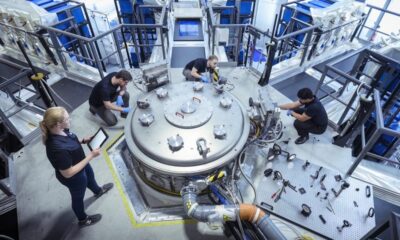Science
UK Breakthrough in Fusion Energy Promises Limitless Power Potential

A groundbreaking advancement in fusion energy has been achieved by First Light Fusion (FLF) in the United Kingdom, marking a significant milestone toward the development of a commercially viable fusion reactor. This breakthrough involves a new method for achieving high gain in inertial fusion, a process that could ultimately provide near-limitless energy and reduce reliance on fossil fuels.
Fusion power harnesses the energy released during nuclear fusion reactions, which occur when two light atomic nuclei combine to form a heavier nucleus. This reaction releases substantial energy, which, if captured and converted into electricity, could revolutionize the global energy landscape. Despite numerous advances in fusion research, a fully operational reactor has remained elusive.
First Light Fusion’s Innovative Approach
First Light Fusion’s latest achievement focuses on a process called FLARE, or Fusion via Low-power Assembly and Rapid Excitation. This innovative method has the potential to achieve a gain of 1,000, significantly higher than the previous record of four, established by the U.S. Department of Energy’s National Ignition Facility in May 2025.
In the realm of fusion energy, “gain” refers to the ratio of energy produced by a fusion reaction compared to the energy input required to initiate it. The aspiration of achieving sustainable gain has long been the Holy Grail for researchers, as earlier experiments have typically consumed more energy than they generated. FLARE represents a promising step forward by separating the processes of compressing and heating fuel, allowing for a substantial surplus of energy through a technique known as “fast ignition.”
FLF asserts in its white paper that just one kilogram (2.2 lbs) of fusion fuel has the energy potential equivalent to that of 10 million kg of coal, emphasizing the substantial advantages of fusion power over conventional fossil fuels.
The Path to Sustainable Fusion Energy
Achieving ignition requires heating a small amount of fuel to fusion temperatures, reaching around 100 million kelvin (approximately 180 million degrees Fahrenheit). This level of heat production exceeds that found at the core of the sun and necessitates considerable energy input. Nevertheless, the ability to reach self-sustaining fusion would lead to a transformative increase in energy production capabilities.
While this recent breakthrough is a monumental step in the right direction, it is essential to acknowledge that it is just one phase in the extensive journey toward establishing fusion power plants that could potentially replace non-renewable energy sources. The prospect of multiple reactors generating vast amounts of energy for global needs now appears more feasible, with numerous advancements in fusion research paving the way.
Experts in the energy sector view this achievement as a vital component in the quest for sustainable energy solutions. If FLARE performs as theorized, it could set the foundation for a future where humanity can rely on clean, efficient fusion energy, drastically reducing carbon emissions and combating climate change.
As fusion technology continues to advance, the dream of harnessing this powerful energy source moves closer to reality, potentially transforming the way we approach energy production and consumption worldwide.
-

 Entertainment2 months ago
Entertainment2 months agoAnn Ming Reflects on ITV’s ‘I Fought the Law’ Drama
-

 Entertainment3 months ago
Entertainment3 months agoKate Garraway Sells £2 Million Home Amid Financial Struggles
-

 Health2 months ago
Health2 months agoKatie Price Faces New Health Concerns After Cancer Symptoms Resurface
-

 Entertainment2 months ago
Entertainment2 months agoCoronation Street’s Carl Webster Faces Trouble with New Affairs
-

 Entertainment2 months ago
Entertainment2 months agoWhere is Tinder Swindler Simon Leviev? Latest Updates Revealed
-

 Entertainment3 months ago
Entertainment3 months agoKim Cattrall Posts Cryptic Message After HBO’s Sequel Cancellation
-

 Entertainment2 months ago
Entertainment2 months agoOlivia Attwood Opens Up About Fallout with Former Best Friend
-

 Entertainment2 months ago
Entertainment2 months agoMasterChef Faces Turmoil as Tom Kerridge Withdraws from Hosting Role
-

 Entertainment3 months ago
Entertainment3 months agoMarkiplier Addresses AI Controversy During Livestream Response
-

 Science2 weeks ago
Science2 weeks agoBrian Cox Addresses Claims of Alien Probe in 3I/ATLAS Discovery
-

 Entertainment4 months ago
Entertainment4 months agoSpeculation Surrounds Home and Away as Cast Departures Mount
-

 World2 months ago
World2 months agoCole Palmer’s Mysterious Message to Kobbie Mainoo Sparks Speculation




















